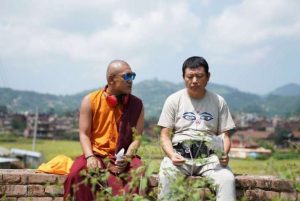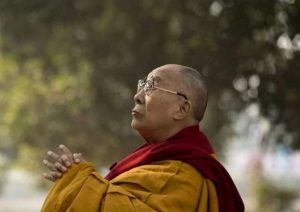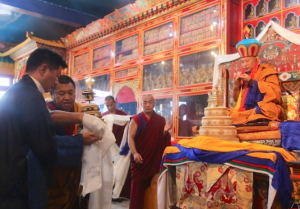
In my last article, I detailed my profound experience at the Hua-yen Sūtra performance in June 2007, which prompted me to immerse myself in Thích Nhất Hạnh’s teachings through his books and practices. My journey continued with a memorable public talk by Ven. Thích Chân Pháp Ấn from Plum Village and Rev. Dr. Thomas Kwan in April 2010, followed by a talk and calligraphy exhibition by Thích Nhất Hạnh in Hong Kong in November 2010. They further enriched my appreciation of his work.
I also mentioned attending a five-day mindfulness retreat organized by the Asian Institute of Applied Buddhism (Plum Village Hong Kong) at Lotus Pond Temple on Lantau Island in March 2012. In this article, I will reveal what happened during that retreat and how it ignited my desire to visit Plum Village in France.
It was the first time I had attended any kind of retreat. I felt both nervous and excited after completing my registration. I particularly wanted to know what daily life in a temple looked like and how that could help people deepen their mindfulness. The retreat was not an easy experience, but I developed a deeper understanding of myself and the practices during those five days. I will share two of my most unforgettable experiences.
The first experience illustrated the power of mindful breathing, revealing how it can transform one’s state of mind and body even in adverse conditions. There were two types of accommodation at the retreat: dormitory beds and outdoor camping. Since I wanted to be closer to nature, I chose camping. When I arrived that afternoon, the weather was still quite pleasant. However, it gradually worsened, with strong winds and falling temperatures. By evening, the winds were as fierce as a typhoon, and the temperature had dropped to just a few degrees. Surrounded by trees, even with the doors and windows of the temple closed, I could still hear the loud sounds of the winds and branches, and I felt cold.
The tent set up on the grass in front of the temple swayed wildly in the strong winds. When bedtime came, it was very difficult for me to get into the tent. Inside that unsteady tent, even sitting and organizing my things was a challenge. After much effort, I finally managed to settle into my sleeping bag. However, under such conditions, falling asleep was nearly impossible. The small tent was surrounded by large trees that swayed continuously, creating a tremendous noise. The tent itself was also flapping loudly, which I believed far exceeded any acceptable noise level. To make matters worse, the tent kept brushing against my face due to the winds. To reduce these disturbances, I had to bury my head under the covers.
In addition to the strong winds outside, my mind was also in turmoil. Worries and anxieties spun endlessly in my mind: “Would the tent be able to withstand such strong winds? When would the winds die down? How could I possibly sleep in such noise and cold? If I don’t get enough rest tonight, I won’t have the energy to practice in the following days . . .”
The more I thought, the more chaotic my mind became. After three hours, I still had not fallen asleep. Suddenly, I found myself thinking: “Since I’m here for meditation, why not practice mindful breathing right now?” So I returned to my breath. Regardless of whether it was fast or slow, long or short, deep or shallow, I simply observed each in-breath and out-breath.
A miraculous thing happened: within minutes, I fell asleep! Not only that, but when I woke up the next morning, I felt quite refreshed. Mindful breathing can bring the mind back to the body. When we are in harmony with ourselves and stay in the present moment, neither the strong winds outside nor the turmoil inside can affect us anymore. Mindful breathing proved to be a very effective way to weather emotional storms.
Additionally, I believe the sudden idea to return to my breath during moments of distress was a result of my regular mindfulness practice. Without that consistent practice, I likely would not have thought to focus on my breathing in challenging moments, underscoring the importance of maintaining a regular mindfulness practice.
The second experience related to the “Bells of Mindfulness,” an essential practice at Plum Village. At the retreat, we often heard the sound of the bell. The duration of the sound varied each time; sometimes it lasted only a few seconds, while at other times it continued for over 10 seconds. During these moments, we were required to stop all activities and return to our breathing. This practice aimed to help us anchor ourselves in the present moment.
From the start of the retreat, whenever I heard the bell, I paused whatever I was doing—whether eating, walking, talking, working, or engaged in other activities—and practiced mindful breathing until the sound ended. I enjoyed this practice very much. Each time I returned to my breath, I felt refreshed, stable, and at ease.
I did this practice well until the fourth day. That morning, I woke up late, so I rushed to the toilet to wash and dress. At that moment, the bell sounded. However, I did not notice it until the third sound, when I saw that other retreatants had already stood still. After I had stopped moving, instead of practicing mindful breathing, I just impatiently hoped the bell would stop soon because “I am in a hurry!” It was not until another three sounds that I remembered to go back to my breathing.
It thus took six sounds to bring my hurried mind back to the present. As I engaged in mindful breathing during the remaining sounds of the bell, I became aware of the tension in my body and mind. This experience highlighted how easily my mind could be diverted by external pressures and internal haste. The sounds of the bell could pierce through my preoccupation, providing a necessary reminder to pause and reconnect with the present moment.
Moreover, this experience demonstrated the power of practicing with a community. It was the sight of the other retreatants that helped me remember to pause and return to mindfulness. My practice, therefore, could deepen and flourish in ways that were not possible when done alone. In group practice, the collective presence and shared commitment provide a strong support system.
Having gained valuable insights about myself and the various practices from this short retreat, I imagined the benefits would be tremendous if I could stay for an extended period. It would also be profound to practice at Plum Village in France, the first and largest monastic community and retreat center founded by Thích Nhất Hạnh, where the Zen master resided. The significant impact of the retreat experience ignited my desire to visit there.
A few months later, in October 2012, I attended another retreat organized by the Asian Institute of Applied Buddhism (Plum Village Hong Kong). Although this was only a three-day retreat, it deepened my appreciation for the practices and reaffirmed my aspiration to immerse myself in the larger Plum Village community.
In May 2013, Thích Nhất Hạnh visited Hong Kong once more, and I attended his public talk “Happiness is the Way” at the Hong Kong Coliseum. By then, my longing to visit Plum Village in France had intensified even further.
At the same time, I felt ready to pursue further studies and was preparing a doctoral study proposal. The seed of researching Thích Nhất Hạnh’s teachings and practices, along with the desire to spend time at Plum Village in France, had been planted in both my heart and mind, as described in my previous two articles and above. The process, however, was not straightforward. Somehow, step by step, my research titled “Mindfulness, Interbeing, and the Engaged Buddhism of Thích Nhất Hạnh,” which included fieldwork at Plum Village in France, gradually came to fruition.
This article concludes my formative encounters with Thích Nhất Hạnh’s teachings and practices. My next article will look at mindfulness, exploring Thích Nhất Hạnh’s unique interpretation of the practice and its relevance to the modern world.
Related features from BDG
Formative Encounters with Thích Nhất Hạnh’s Teachings and Practices, Part 2
Formative Encounters with Thích Nhất Hạnh’s Teachings and Practices, Part 1
Embarking on the Path: The Origin of My Thích Nhất Hạnh PhD Research














